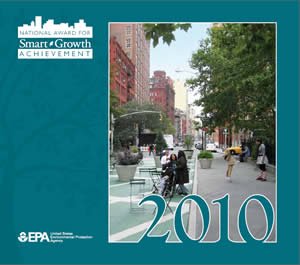2010 National Award for Smart Growth Achievement Booklet
From 2002 to 2015, EPA presented the National Award for Smart Growth Achievement to recognize and support communities that used innovative policies and strategies to strengthen their economies, provide housing and transportation choices, develop in ways that bring benefits to a wide range of residents, and protect the environment.
Awards were given in the following categories in 2010:
- Overall Excellence: Smart.Growth@NYC: Policies and Programs for Improving Livability in New York City, New York City Department of Transportation with the Departments of Health, Design and Construction, and City Planning in New York, New York
- Smart Growth and Green Building: Miller’s Court, Baltimore City Department of Housing and Community Development, Seawall Development Company, Hamel Builders, and Marks, Thomas Architects in Baltimore, Maryland
- Programs, Policies and Regulations: Making the Greatest Place: Metro’s Strategic Implementation of the 2040 Growth Concept in Portland, Oregon
- Rural Smart Growth: Gateway 1 Corridor Action Plan, Gateway 1 Communities and Maine Department of Transportation in the State of Maine
- Civic Places: Mint Plaza, City and County of San Francisco, Martin Building Company, CMG Landscape Architects, and Sherwood Design Engineers in San Francisco, California
Overall Excellence: Smart.Growth@NYC: Policies and Programs for Improving Livability in New York City, New York City Department of Transportation with the Departments of Health, Design and Construction, and City Planning in New York, New York
This Smart Growth Award recognized how PlaNYC 2030, Mayor Bloomberg’s 2007 blueprint for responsibly growing New York City, provided the inspiration for multi-agency coordination on innovative smart growth policies and projects.
Times Square, for example, was redesigned to include new pedestrian areas as a result of the "Green Lights for Midtown" project, a major initiative in the city's efforts to improve mobility and safety.
For an update on this project, see the “How Smart Growth Protects the Environment” section of the 2011 National Award for Smart Growth Achievement booklet.
Smart Growth and Green Building: Miller’s Court, Baltimore City Department of Housing and Community Development, Seawall Development Company, Hamel Builders, and Marks, Thomas Architects in Baltimore, Maryland
This Smart Growth Award recognized Miller’s Court. This project was a model of integrating mixed-use redevelopment with preservation of a landmark historic building and sustainable design principles to help revitalize an entire community.
Programs, Policies, and Regulations: Making the Greatest Place: Metro’s Strategic Implementation of the 2040 Growth Concept in Portland, Oregon
This Smart Growth Award recognized how Metro, the elected regional government of the Portland area, encouraged sustainable land use for future population growth through its Making the Greatest Place effort, which builds on the 2040 Growth Concept.
Thanks to this effort, the region saw more compact development projects and relieved pressure on the urban growth boundary.
For an update on this project, see the “How Smart Growth Protects the Environment” section of the 2012 National Award for Smart Growth Achievement booklet.
Rural Smart Growth: Gateway 1 Corridor Action Plan, Gateway 1 Communities and Maine Department of Transportation in the State of Maine
This Smart Growth Award recognized the Gateway 1 Corridor Action Plan, a collective effort by 20 towns to preserve the economy, environment, and quality of life along the regionally significant U.S. Route 1 corridor. The corridor runs from Brunswick in southern Maine to Stockton Springs, framing Maine’s central coast area. Bath's city center, for example, retained its small-town feel due to the Gateway 1 effort.
Civic Places: Mint Plaza, City and County of San Francisco, Martin Building Company, CMG Landscape Architects, and Sherwood Design Engineers in San Francisco, California
This Smart Growth Award recognized the redesign and redevelopment of Mint Plaza. Located in downtown San Francisco, Mint Plaza was formerly derelict, city-owned alley that was converted into a lively public plaza and festival space with an innovative stormwater system. Impromptu shows and concerts helped contributed to the "public living room" of Mint Plaza.

